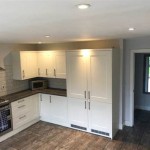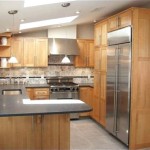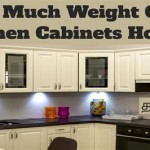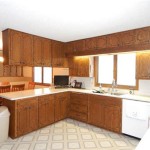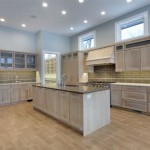Kitchen Cabinets Drawers Replacement: A Comprehensive Guide
Kitchen cabinets drawers are essential components of kitchen storage, providing convenient access to cookware, utensils, and various kitchen items. Over time, however, these drawers can degrade due to wear and tear, improper use, or even water damage. Recognizing the signs of failing drawers and understanding the replacement process can ensure a functional and aesthetically pleasing kitchen space. This article aims to provide a comprehensive guide to kitchen cabinet drawer replacement, focusing on assessing the need for replacement, selecting appropriate replacement options, and outlining the steps involved in the installation process.
Identifying the Need for Drawer Replacement
The initial step in addressing drawer issues is accurately determining whether replacement is the necessary course of action. Several indicators can signal that a drawer is beyond repair and warrants complete replacement. These include structural damage, such as cracked or warped drawer boxes, damaged drawer slides, and significant cosmetic imperfections.
Structural damage compromises the drawer's ability to support weight and function smoothly. Cracks in the drawer box, often caused by excessive weight or impact, weaken the entire structure. Warping, typically resulting from moisture exposure, can distort the drawer's shape, preventing it from fitting properly within the cabinet frame. Damaged drawer slides, responsible for the smooth gliding motion of the drawer, are another critical indicator. Bent, broken, or rusted slides can cause the drawer to stick, bind, or even fall out completely.
Cosmetic imperfections, while not as critical as structural issues, can also warrant replacement if they significantly detract from the kitchen's overall appearance. Deep scratches, stains that cannot be removed, or peeling veneer can make the drawers look worn and unattractive. In some cases, these imperfections may be repairable, but if the damage is extensive, replacement may be the more cost-effective solution.
Furthermore, consider the age and quality of the existing drawers. If the cabinets are old and the drawers are made of low-quality materials, replacing them with newer, more durable options can significantly improve the kitchen's functionality and aesthetics. Upgrading to soft-close mechanisms or full-extension slides can provide added convenience and enhance the overall kitchen experience.
Selecting Replacement Drawers: Materials, Styles, and Hardware
Once the decision to replace the drawers has been made, selecting the appropriate replacement options becomes crucial. This involves considering several factors, including the drawer material, style, hardware, and dimensions.
Several materials are commonly used for kitchen cabinet drawers, each with its own advantages and disadvantages. Solid wood, such as maple, oak, or birch, offers durability, stability, and a classic aesthetic. However, solid wood can be more expensive and susceptible to moisture damage if not properly sealed. Plywood, constructed from layers of wood veneer, provides a cost-effective alternative to solid wood while still offering good strength and stability. Medium-density fiberboard (MDF), an engineered wood product, is another affordable option that is less prone to warping than solid wood but can be more susceptible to water damage. The most affordable option is particleboard but it is the least durable of the common materials for drawer construction and is very prone to water damage.
The style of the replacement drawers should complement the overall design of the kitchen cabinets. Options range from traditional raised-panel drawers to modern slab-front drawers. Consider the cabinet door style, hardware finishes, and overall color scheme when selecting the drawer style. Ensuring consistency in design elements creates a cohesive and visually appealing kitchen space.
Drawer hardware, including drawer pulls, knobs, and slides, plays a significant role in both the functionality and aesthetics of the drawers. Drawer pulls and knobs are available in a wide variety of styles, materials, and finishes, allowing for customization to match the kitchen's décor. Drawer slides, responsible for the smooth gliding motion of the drawers, come in various types, including side-mount, under-mount, and center-mount options. Soft-close slides, which prevent the drawers from slamming shut, are a popular upgrade that adds convenience and reduces noise.
Accurate measurements are critical when selecting replacement drawers. Measure the width, height, and depth of the existing drawer box to ensure a proper fit within the cabinet frame. Also, consider the thickness of the drawer front and the type of drawer slide used. Taking precise measurements prevents installation problems and ensures that the replacement drawers function smoothly.
The Drawer Replacement Process: A Step-by-Step Guide
The drawer replacement process involves several steps, from removing the old drawers to installing the new ones. Proper preparation and attention to detail are crucial for a successful outcome.
Begin by removing the existing drawers from the cabinet frames. Extend the drawer fully and locate the release mechanism on the drawer slides. This mechanism typically consists of a lever or clip that needs to be depressed or lifted to release the drawer from the slides. Once the drawer is released, carefully pull it out of the cabinet frame. Remove the drawer slides from the cabinet frame and the drawer box, if you are repurposing these and not purchasing new slides and brackets.
Prepare the cabinet frame for the new drawer slides. Ensure that the interior of the cabinet frame is clean and free of debris. If necessary, repair any damage to the cabinet frame before installing the new slides. Measure and mark the location of the new drawer slides on the cabinet frame, ensuring that they are aligned properly.
Install the new drawer slides on the cabinet frame and the drawer box. Follow the manufacturer's instructions for installing the specific type of drawer slides being used. Ensure that the slides are securely attached and aligned properly. If using side-mount slides, ensure that they are level and parallel to each other. If using under-mount slides, ensure that they are properly aligned with the mounting brackets.
Insert the new drawers into the cabinet frame. Align the drawer slides on the drawer box with the corresponding slides on the cabinet frame. Gently push the drawer into the cabinet frame until it clicks into place. Test the drawer's movement to ensure that it glides smoothly and does not bind or stick.
Install the drawer front and hardware. Attach the drawer front to the drawer box using screws or other appropriate fasteners. Ensure that the drawer front is aligned properly and flush with the cabinet frame. Install the drawer pulls or knobs, ensuring that they are securely attached and properly aligned. Test the drawer again to ensure that it functions smoothly and the hardware is securely in place.
Finally, inspect the installation to ensure that the drawers are functioning properly and that all hardware is securely attached. Make any necessary adjustments to the drawer slides or hardware to ensure smooth and consistent operation. Clean the drawer fronts and surrounding cabinet surfaces to remove any dirt or fingerprints.
Replacing kitchen cabinet drawers can significantly enhance the functionality and aesthetics of a kitchen. By carefully assessing the need for replacement, selecting appropriate replacement options, and following a step-by-step installation process, homeowners can achieve professional-looking results that improve the overall kitchen experience.
Choosing the right replacement drawers can lead to better organization and easier access to frequently used items. Consider incorporating dividers or organizers within the drawers to maximize storage space and keep items neatly arranged. This attention to detail will further enhance the functionality and convenience of the kitchen.
While this guide provides a detailed overview of the drawer replacement process, homeowners who are not comfortable with DIY projects may consider hiring a professional contractor to handle the installation. A professional can ensure that the drawers are installed correctly and that any potential problems are addressed promptly. Professional installation can also save time and effort, particularly for complex or extensive kitchen renovations.

Replacement Cabinet Drawer Box 11 Doors N More

How To Replace Kitchen Drawers Shelfgenie

How To Replace Kitchen Drawers Shelfgenie

Surfaces 14 In W X 4 H 18 D Natural Maple Finished Cabinet Drawer Box The Kitchen Accessories Department At Com

Cabinet Hardware Drawer Inserts Triangle Pacific

Replacement Wood Drawer Boxes Cabinet Doors N More

Cabinet Drawer Front Raised Inner Panel Bevel Round Edge Doors N More

Cabinet Drawer Box Kitchen Accessories At Com

Replacement Wood Drawer Boxes Cabinet Doors N More

Replacement Wood Drawer Boxes Cabinet Doors N More
Related Posts


